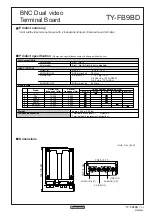
8
User's Guide ADI-648 © RME
6. The MADI to ADAT Converter
6.1 General
This part of the ADI-648 converts MADI to ADAT optical. MADI offers 64 channels of 24 bit
audio at up to 48 kHz sample rate, and 32 channels at up to 96 kHz. Transmission happens
over a single line, either coaxial (BNC) or fiber optic (network). In both cases the cable length
can be more than 100 meters.
The 64 MADI channels are transferred to 8 ADAT optical outputs (TOSLINK). Furthermore, the
ADI-648 contains an easy-configurable 8-channel 16x16
Matrix Router
. Any of the outputs,
which are divided into 8-channel blocks, can be fed from any 8-channel input block, both on the
ADAT and the MADI side. With this, there is not only free routing within the MADI to ADAT
conversion, but also splitting and routing within the same format.
6.2 Inputs
Both MADI inputs are located on the rear of the ADI-648.
The BNC input's ground-free design is built according to AES10-1991. The input's impedance is
75 Ohm. It will operate error-free from about 180 mVpp.
The optical input uses a FDDI (ISO/IEC 9413-3) compatible optical module, according to
AES10-1991. More information can be found in chapter 11.2, MADI Basics.
The ADI-648 includes automatic input selection. In case the current input signal fails, the unit
switches to the other input immediately. This mode, called redundancy mode, offers improved
safety against errors on the transmission line. Switching the inputs is done in about one second.
The ADI-648 displays redundancy operation by a blinking LED of the original input, while the
input LED of the currently active input will be lit constantly.
6.3 Input State Display
The state of the MADI input is displayed by different LEDs. The ERROR LED is directly cou-
pled with the MADI-Receiver, and informs the user reliably about the quality of the input signal.
The LED will light up red, as soon as there is any error, be it a carrier voltage which is too low,
invalid data or any other error which prevents the receiver from accepting the input signal.
If a valid input signal is applied, SyncCheck is active automatically. If the MADI input is not
chosen as clock source, SyncCheck takes the chosen clock (Internal, External, ADAT) as ref-
erence and compares it with the MADI input clock. In case no synchronous operation is de-
tected the SYNC LED will start blinking.
Audio data present in the input channels is signalled by an AUDIO LED. As the ADI-648 is
based on ADAT ports and therefore operates in 8-channel blocks, an AUDIO LED will show
audio data from 8 channels simultaneously. The green LED is lit as soon as one of the chan-
nels of an 8-channel block contains audio data, that is no longer digital zero.









































